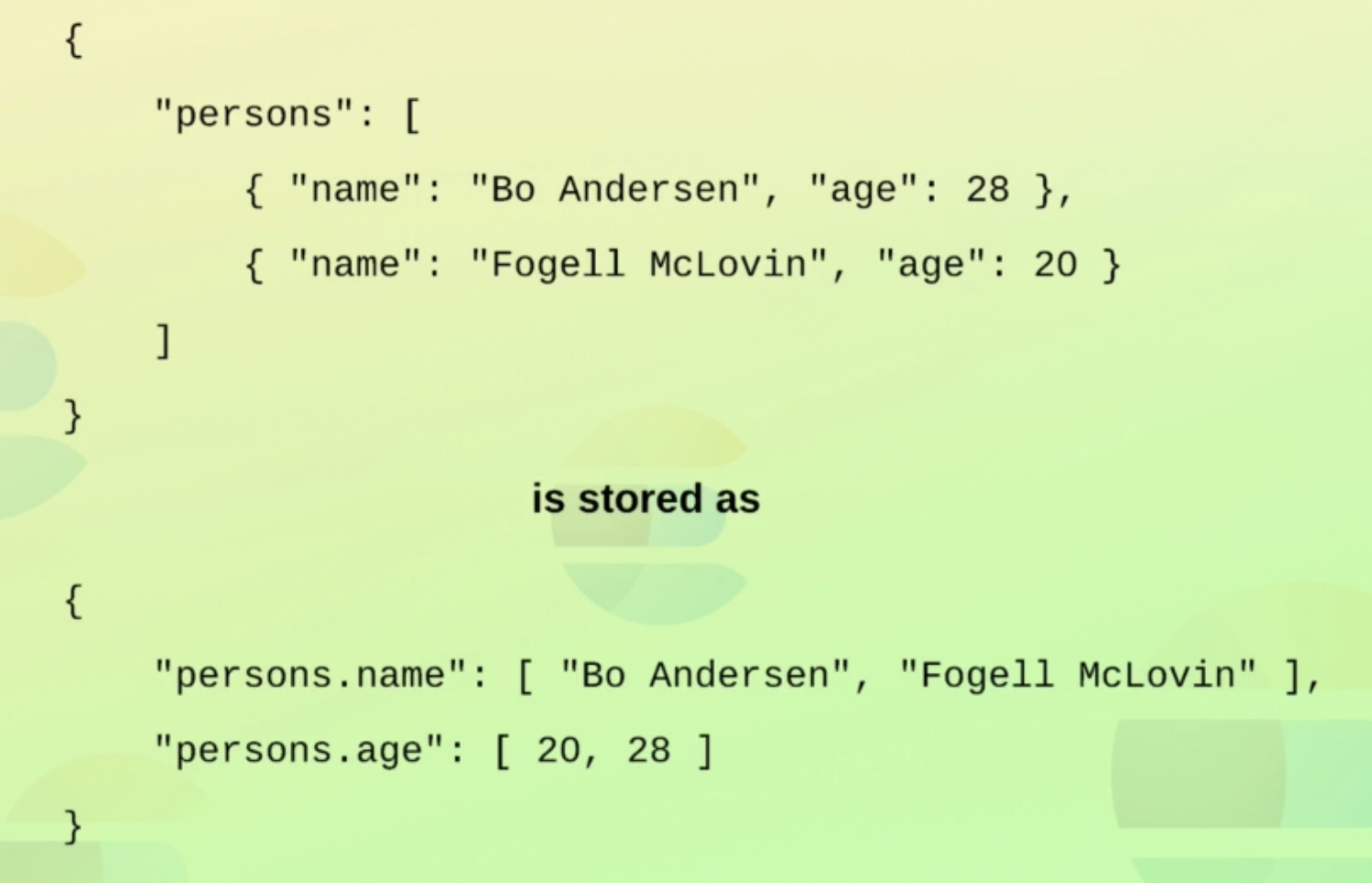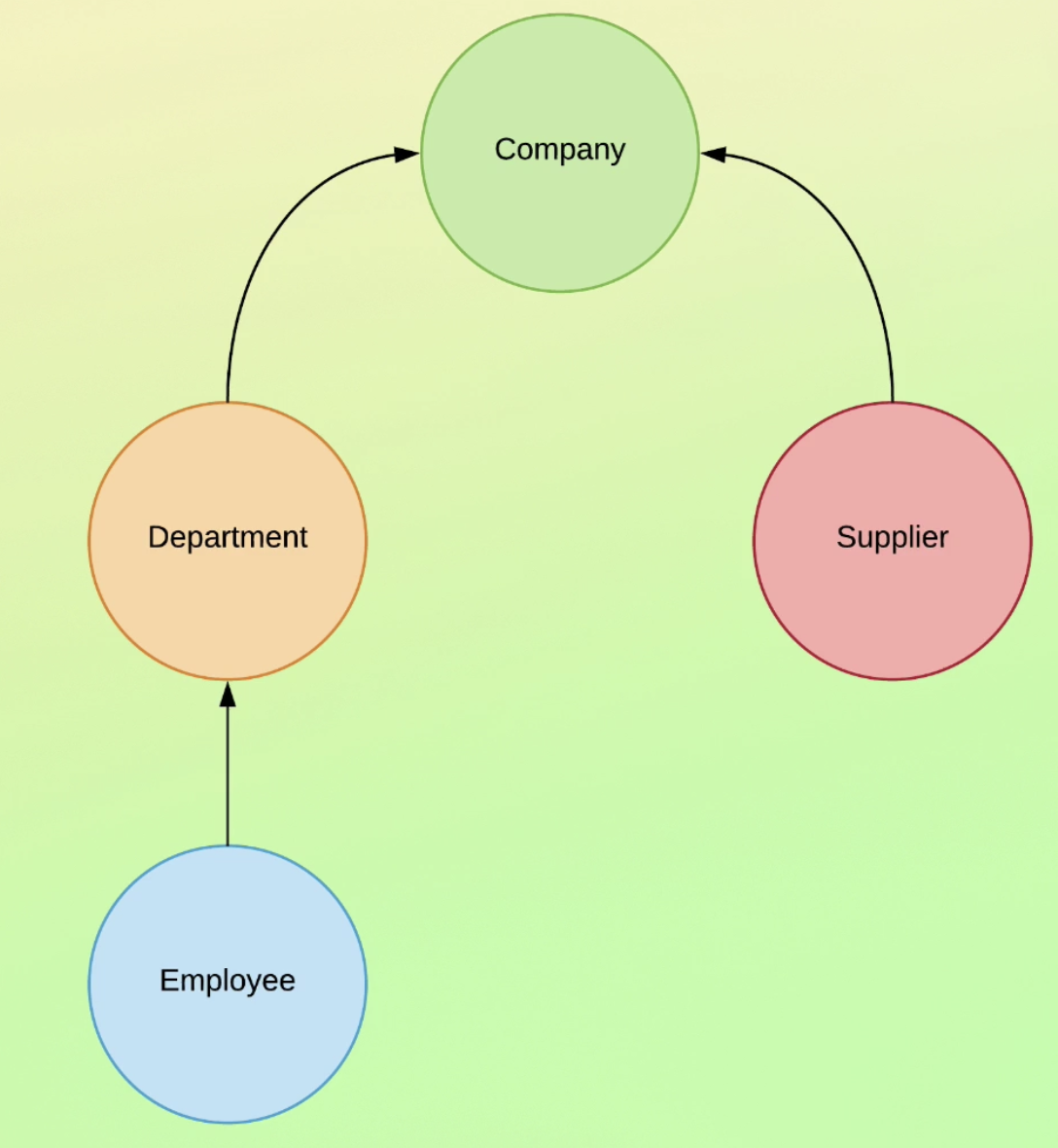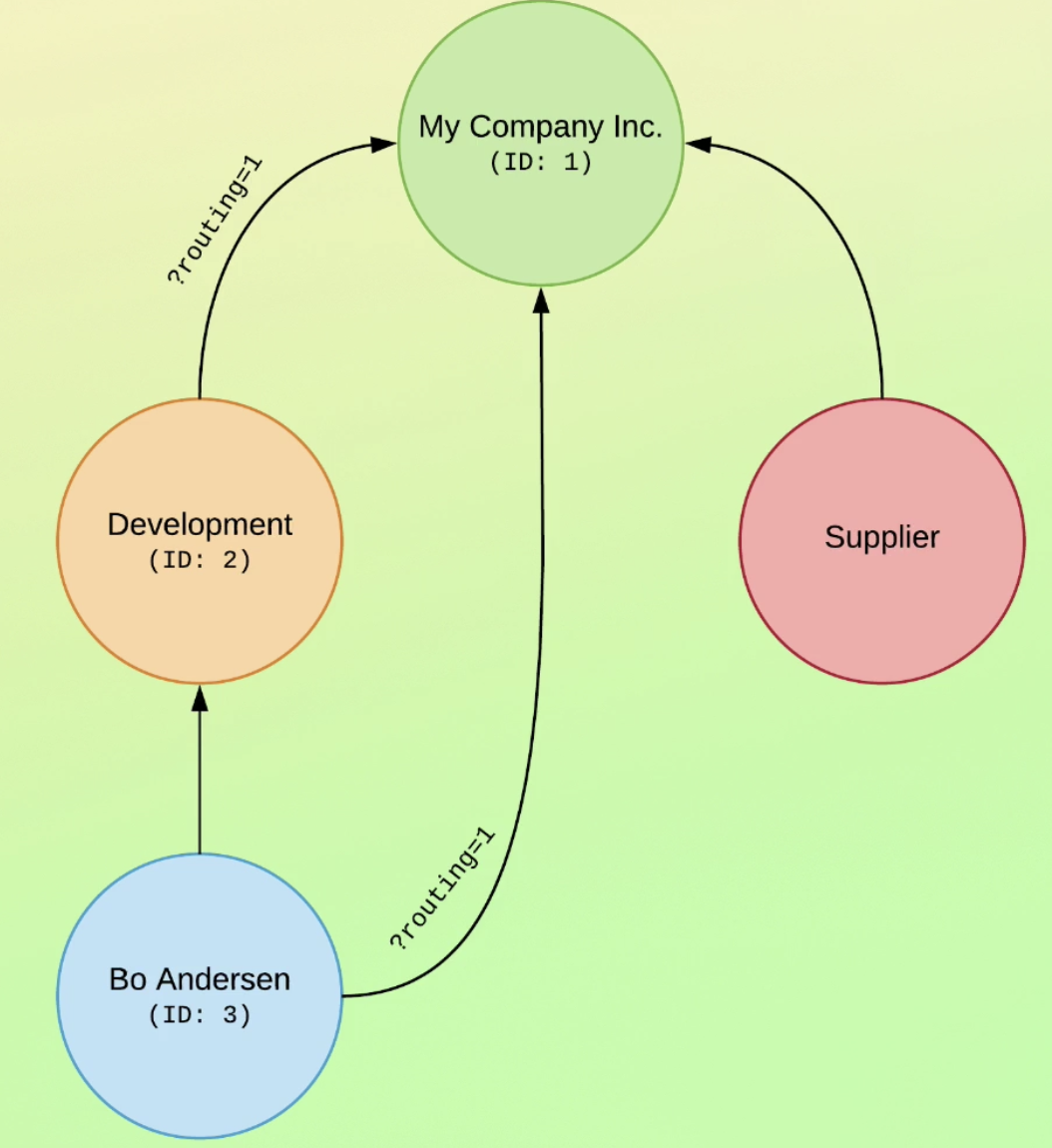前言
這篇文章是出自於線上課程 Complete Guide to Elasticsearch 的所記錄的筆記。
這篇文章使用的 ES 版本為 7.16.2
這一篇文章要來介紹如何透過 Elastic 的 join queries 來達成與 RDBMS 一樣 join 兩張 table 的效果。
正文
在 RDBMS 中,透過正規化的方式將大表分成多個小表,並再透過 join 的方式將它們結合在一起。
然而在 Elastic 中,反而是建議 **反正規化 (Denomornize)**,因為這樣帶來的效益對 ES 而言會更好,雖然反正規化會讓空間使用上的效益不佳,但通常 ES 都不會被拿來當作主要的資料庫,而是會為了追求效能兒犧牲空間。
雖然 ES 並不能做到像 RDBMS 的 join,但還是能達到一些簡易的 document join。
查詢 nested objects
當我們新增一個包含 nested 欄位的 index department
1
2
3
4
5
6
7
8
9
10
11
12
13
| PUT /department
{
"mappings": {
"properties": {
"name": {
"type": "text"
},
"employees": {
"type": "nested"
}
}
}
}
|
新增一筆資料
1
2
3
4
5
6
7
8
9
10
11
12
13
14
15
16
17
18
| POST /department/_doc
{
"name": "HR",
"employees": [
{
"name": "Joy",
"age": "42",
"position": "Senior Marketing Manager",
"gender": "F"
},
{
"name": "Toe",
"age": "18",
"position": "Interm",
"gender": "M"
}
]
}
|
今天當要搜尋 employees 的資料時,透過下面這個方法是行不通的
1
2
3
4
5
6
7
8
9
10
11
12
13
14
15
16
17
18
19
| GET /department/_search
{
"query": {
"bool": {
"must": [
{
"match": {
"employees.position": "nterm"
}
},
{
"term": {
"employees.gender.keyword": "M"
}
}
]
}
}
}
|
因為 nested 欄位的資料,雖然原本是 object,但實際儲存在 ES 會變得不一樣,資料與資料之間會變得沒有關係。

Inner hits
透過 inner hits 的查詢,可以進一步查詢 nested 的欄位中,真正符合條件的資料。
加入 _source: false 讓資料不要那麼龐大
1
2
3
4
5
6
7
8
9
10
11
12
13
14
15
16
17
18
19
20
21
22
23
24
25
26
| GET /department/_search
{
"_source": false,
"query": {
"nested": {
"path": "employees",
"inner_hits": {},
"query": {
"bool": {
"must": [
{
"match": {
"employees.position": "interm"
}
},
{
"term": {
"employees.gender.keyword": "M"
}
}
]
}
}
}
}
}
|
透過 inner hits 可以看到符合條件的搜尋更詳盡的資料
1
2
3
4
5
6
7
8
9
10
11
12
13
14
15
16
17
18
19
20
21
22
23
24
25
26
27
28
29
30
31
32
33
34
35
36
37
38
39
40
41
42
43
44
45
46
47
48
49
50
51
52
53
54
55
| {
"took" : 1,
"timed_out" : false,
"_shards" : {
"total" : 1,
"successful" : 1,
"skipped" : 0,
"failed" : 0
},
"hits" : {
"total" : {
"value" : 1,
"relation" : "eq"
},
"max_score" : 1.5645323,
"hits" : [
{
"_index" : "department",
"_type" : "_doc",
"_id" : "GQkfI34BeiHXdjTu0YQ5",
"_score" : 1.5645323,
"inner_hits" : {
"employees" : {
"hits" : {
"total" : {
"value" : 1,
"relation" : "eq"
},
"max_score" : 1.5645323,
"hits" : [
{
"_index" : "department",
"_type" : "_doc",
"_id" : "GQkfI34BeiHXdjTu0YQ5",
"_nested" : {
"field" : "employees",
"offset" : 1
},
"_score" : 1.5645323,
"_source" : {
"gender" : "M",
"name" : "Toe",
"position" : "Interm",
"age" : "18"
}
}
]
}
}
}
}
]
}
}
|
Document relationships 的 mappings
新增一筆 deparment 與 employee 的 mapping,join_field 是自定義的名字
1
2
3
4
5
6
7
8
9
10
11
12
13
| PUT /department
{
"mappings": {
"properties": {
"join_field": {
"type": "join",
"relations": {
"department": "employee"
}
}
}
}
}
|
新增一筆 department
1
2
3
4
5
| PUT /department/_doc/1
{
"name": "Development",
"join_field": "department"
}
|
新增一筆 employee
1
2
3
4
5
6
7
8
9
10
11
| # 指向 parent
PUT /department/_doc/3?routing=1
{
"name": "percy",
"age": 27,
"gender": "M",
"join_field": {
"name": "employee",
"parent": 1
}
}
|
routing 指的是資料要儲存在哪一個 shard,這個值是透過 document ID 而來,如果不指定的話會發生錯誤 - [routing] is missing for join field [join_field]”
Query by parent ID
透過 parent ID 的方式來查詢資料,type 需填入與 parent 相關的 child。
1
2
3
4
5
6
7
8
9
| GET /department/_search
{
"query": {
"parent_id": {
"type": "employee",
"id": 1
}
}
}
|
Query child doc by parent
有時候我們並不曉得 child 的 parent ID 為何,因此可以透過是否有 parent 來判別。
1
2
3
4
5
6
7
8
9
10
11
12
13
| GET /department/_search
{
"query": {
"has_parent": {
"parent_type": "department",
"query": {
"term": {
"name.keyword": "Development"
}
}
}
}
}
|
parent matching 預設是不計算分數的,若要啟用,可以補上 score: true
1
2
3
4
5
6
7
8
9
10
11
12
13
14
| GET /department/_search
{
"query": {
"has_parent": {
"score": true,
"parent_type": "department",
"query": {
"term": {
"name.keyword": "Development"
}
}
}
}
}
|
Query parents by child
我們也可以透過 child 來查詢 parent
1
2
3
4
5
6
7
8
9
10
11
12
13
14
15
16
17
18
19
20
21
22
23
24
25
26
27
28
| GET /department/_search
{
"query": {
"has_child": {
"type": "employee",
"query": {
"bool": {
"must": [
{
"range": {
"age": {
"gte": 50
}
}
}
],
"should": [
{
"term": {
"gender.keyword": "M"
}
}
]
}
}
}
}
}
|
child 與 parent 查詢,預設都是不計算分數的,但 child 可以使用的計分方式更多

child 計分的欄位名稱為 score_mode
Multi-level relation
今天資料之間的關係可能不會這麼單純,只有一對 parent & child,而應該是多個 parent & child 所組合成。
假設關係圖如下

將關係圖轉化成 query 的結果如下
1
2
3
4
5
6
7
8
9
10
11
12
13
14
15
16
17
18
19
20
21
22
23
24
| PUT /department/_doc/1
{
"name": "Company",
"join_field": "company"
}
PUT /department/_doc/2?routing=1
{
"name": "Development",
"join_field": {
"name": "department",
"parent": 1
}
}
PUT /department/_doc/3?routing=1
{
"name": "Percy",
"join_field": {
"name": "employee",
"parent": 2
}
}
|

> 唯一要注意的是 employee 的 routing=1,因為資料與最高階層的資料要放在同一個 shard。
儘管階層的關係變多了,但搜尋的方法依然不變
1
2
3
4
5
6
7
8
9
10
11
12
13
14
15
16
17
18
| GET /department/_search
{
"query": {
"has_child": {
"type": "department",
"query": {
"has_child": {
"type": "employee",
"query": {
"term": {
"name.keyword": "Percy"
}
}
}
}
}
}
}
|
inner_hits 也可以用在 has_parent & has_child
Terms lookup mechanism
新增 user & stories 的資料
1
2
3
4
5
6
7
8
9
10
11
12
13
14
15
16
17
18
19
20
21
22
23
24
25
26
| # user 1 追蹤 user 2, 3
PUT /users/_doc/1
{
"name": "John",
"following": [2, 3]
}
# 這些文章是由哪些 user 所建立以及文章內容
PUT /stories/_doc/1
{
"user": 2,
"content": "ya! 2"
}
PUT /stories/_doc/2
{
"user": 3,
"content": "ya! 3"
}
PUT /stories/_doc/3
{
"user": 4,
"content": "ya! 4"
}
|
1
2
3
4
5
6
7
8
9
10
11
12
13
| # 搜尋 user 1 有在追蹤的人所寫的文章
GET /stories/_search
{
"query": {
"terms": {
"user": {
"index": "users",
"id": "1",
"path": "following"
}
}
}
}
|
Join limitation
Join 有以下限制
- 資料必須放在同一個 index,否則效能會非常差
- parent & child 必須放在同一個 shard
- 每個 index 只能有一個 join 欄位
Reference
- Complete Guide to Elasticsearch



 > 唯一要注意的是 employee 的 routing=1,因為資料與最高階層的資料要放在同一個 shard。
> 唯一要注意的是 employee 的 routing=1,因為資料與最高階層的資料要放在同一個 shard。